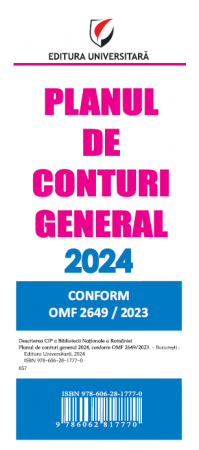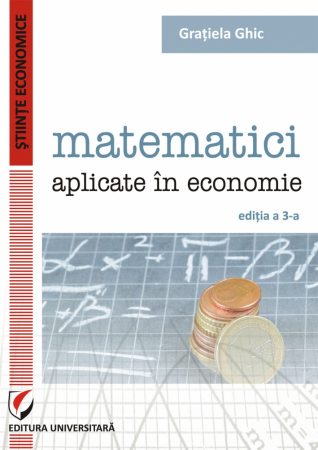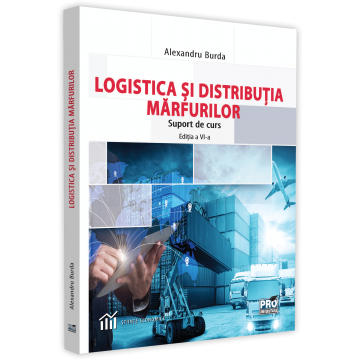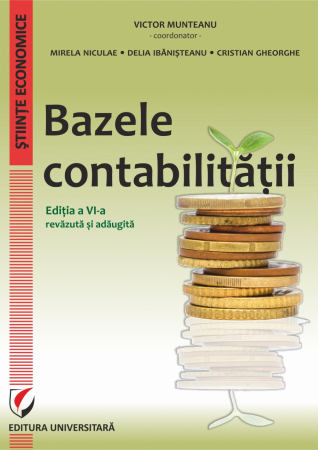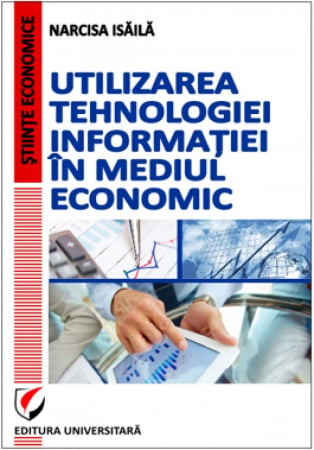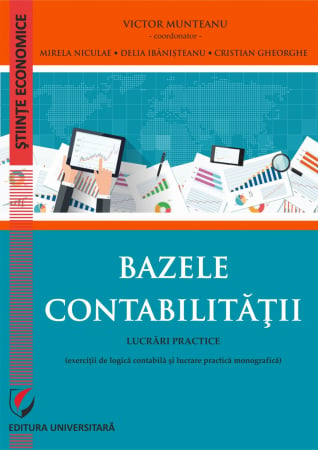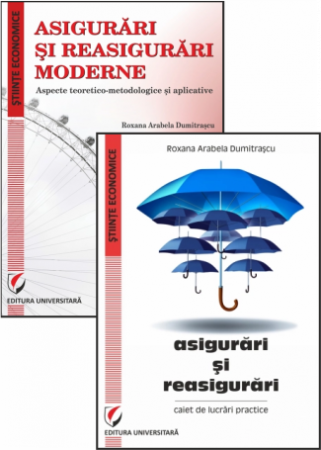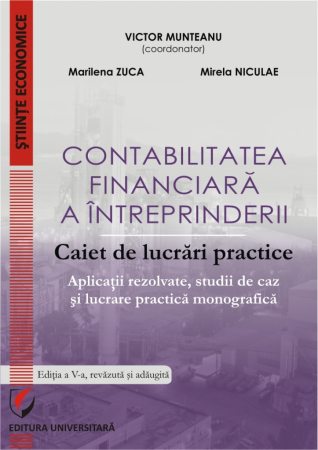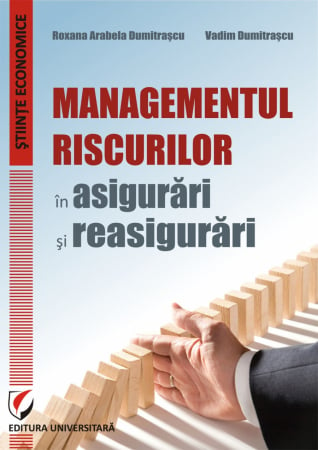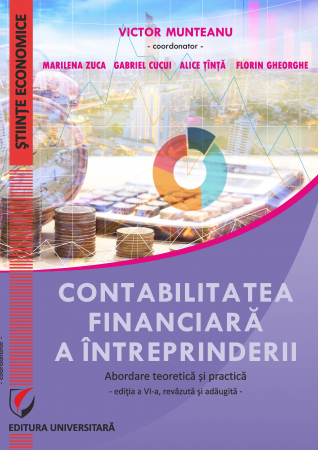Manuscript proposals: [email protected] / 0745 204 115 //// Tracking orders Individuals / Sales: 0745 200 357 / Orders Legal entities: 0721 722 783
6359.png) Payment and Financing Techniques and Instruments Used in International Business, Third Edition - Oana Mionel
Payment and Financing Techniques and Instruments Used in International Business, Third Edition - Oana Mionel
6359.png)
ISBN: 978-606-28-0824-2
DOI: 10.5682/9786062808242
Publisher year: 2018
Edition: III, revizuita si adaugita
Pages: 238
Publisher: Editura Universitară
Author: Oana Mionel
Product Code:
9786062808242
Do you need help?
0745 200 357
- Description
- Download (1)
- Authors
- Content
- More details
- Reviews (0)
The paper was designed to provide an overview of payment and financing techniques in the short, medium and long term, addressing primarily the students of the Faculty of International Business Administration, but also all readers interested in the evolution of payment instruments and existing financing techniques at international level.
In the eleven chapters, written in an accessible way, the paper tries to keep up with the permanent and rapid changes that occur in the international economy, giving readers a clear picture of everything that represents money and the forms in which it is presented. in economics.
In the eleven chapters, written in an accessible way, the paper tries to keep up with the permanent and rapid changes that occur in the international economy, giving readers a clear picture of everything that represents money and the forms in which it is presented. in economics.
-
Payment and Financing Techniques and Instruments Used in International Business, Third Edition
Download
OANA MIONEL
Doctor in economics, title awarded by the Academy of Economic Studies and, at the same time, associate professor at the Faculty of International Economic Relations within the "Dimitrie Cantemir" Christian University.
The author of this paper teaches at the mentioned faculty the subjects: Technique of international payments and financing and International stock exchanges.
Doctor in economics, title awarded by the Academy of Economic Studies and, at the same time, associate professor at the Faculty of International Economic Relations within the "Dimitrie Cantemir" Christian University.
The author of this paper teaches at the mentioned faculty the subjects: Technique of international payments and financing and International stock exchanges.
FOREWORD / 9
PART I
TECHNIQUES AND PAYMENT INSTRUMENTS USED IN INTERNATIONAL BUSINESS / 11
1. THE CIRCUIT OF MONEY IN THE WORLD. FROM THE MONEY IDEA OF THE TEMPLAR KNIGHTS TO ELECTRONIC PAYMENTS / 12
1.1. INTERNATIONAL LABOR DIVISION AND INTERNATIONAL PAYMENTS / 12
1.2. THE APPEARANCE OF MONEY AND THE ELIMINATION OF TRUCK INEFFICIENCY / 12
1.3. CURRENCY AND FOREIGN MARKET / 18
1.4. CURRENCIES / 23
1.5. INTERNATIONAL ECONOMIC RELATIONS AND INVOLVED PARTIES / 26
1.5.1. Importer / 28
1.5.2. Exporter / 29
1.6. NAMES LTD., INC., GMBH OR S.A. IN INTERNATIONAL AFFAIRS / 30
II. PAPER INSTRUMENTS AND WARRANTY INSTRUMENTS / 32
2.1. CECUL / 32
2.1.1. General characterization / 32
2.1.2. Classification of checks / 34
2.1.3. Check operations / 36
2.1.4. Risks of using checks / 38
2.2. THE TICKET ORDER / 38
2.3. PAYMENT ORDER / 40
2.4. PAYMENT ORDER FOR THE STATE TREASURY / 41
2.5. LETTER OF GUARANTEE / 44
III. ELECTRONIC PAYMENTS / 50
3.1. ELECTRONIC PAYMENT INSTRUMENTS / 50
3.1.1. Payment sticker, payment watch and payment bracelet / 50
3.1.2. Bank card / 52
3.1.3. International debit cards / 57
3.1.4. Payment order in electronic format / 59
3.1.5. Payment order for the state treasury in electronic format / 60
3.1.6. Electronic Multiple Payment Order (OPME) / 63
3.1.7. Electronic check / 66
3.2. ELECTRONIC SIGNATURE / 67
3.3. ELECTRONIC BANKING AND INTERNET BANKING / 71
IV. ELECTRONIC PAYMENT SYSTEMS / 76
4.1. ELECTRONIC INTERBANK PAYMENT SYSTEMS / 76
4.1.1. SWIFT, BIC and IBAN / 76
4.1.2. Single Payment Area in Euro / 82
4.1.3. TARGET 2/88
4.2. TRANSFOND - THE ELECTRONIC PAYMENT SYSTEM FROM ROMANIA / 90
4.2.1. SENT / 92
4.2.2. ReGis / 92
4.2.3. SaFIR / 93
4.3. TRANSFER SERVICES BETWEEN PERSONS / 94
4.3.1. Western Union / 94
4.3.2. MoneyGram / 95
4.3.3. Azimo / 95
4.3.4. Smith and Smith / 96
4.3.5. TransferWise / 99
4.3.6. TransferGo / 101
4.3.7. WorldRemit / 104
V. USE OF ACCREDITATION AND DOCUMENTARY COLLECTION IN INTERNATIONAL AFFAIRS / 107
5.1. DOCUMENTARY ACCREDITATION / 107
5.1.1. Definition and characteristics of the documentary letter of credit / 107
5.1.2. The parties involved in the development of the documentary letter of credit / 111
5.1.3. The mechanism of the documentary letter of credit / 113
5.1.4. Types of documentary letters of credit / 115
5.1.5. The documents used in the payment of the documentary letter of credit / 122
5.1.6. Advantages and disadvantages of using the documentary letter of credit / 125
5.2. DOCUMENTARY COLLECTION / 127
5.2.1. Definition and characteristics of the documentary collection / 127
5.2.2. The parties involved in the conduct of the documentary collection / 127
5.2.3. The mechanism for carrying out the documentary collection / 129
5.2.4. Advantages and disadvantages of using the documentary collection / 131
PART II
TECHNIQUES FOR FINANCING INTERNATIONAL BUSINESS / 133
VI. FINANCING INTERNATIONAL BUSINESS / 134
6.1. INTERNAL FINANCING AND EXTERNAL FINANCING / 134
6.2. FINANCIAL INTERMEDIARIES / 137
6.2.1. International financial institutions / 138
6.2.2. Storage institutions / 142
6.2.3. Non-storage institutions / 143
6.2.4. Government intermediation agencies / 148
VII. SHORT - TERM FINANCING TECHNIQUES / 150
7.1. PRE - FINANCING APPROPRIATIONS / 151
7.2. EXPORT CREDITS / 153
7.3. CREDIT LINES / 157
7.4. APPROPRIATIONS FOR FINANCING TEMPORARY / SEASONAL EXPENDITURES AND STOCKS / 158
7.5. GLOBAL OPERATING APPROPRIATIONS / 160
VIII. MEDIUM AND LONG TERM FINANCING TECHNIQUES / 162
8.1. CLASSICAL FINANCING TECHNIQUES / 162
8.1.1. Supplier credit / 162
8.1.2. Buyer credit / 166
8.2. MODERN FINANCING TECHNIQUES / 169
8.2.1. Consortium loan / 169
8.2.2. Revolving credit / 172
8.2.3. Co-financing / 174
IX. LEFT, FACTORING AND LEASING / 178
9.1. FORFETAREA / 178
9.1.1. Presentation of the lump sum concept / 178
9.1.2. Forms of the lump sum offer / 180
9.1.3. Advantages and disadvantages of the lump sum operation / 181
9.2. FACTORING / 184
9.2.1. Presentation of the factoring concept / 184
9.2.2. Types of factoring / 184
9.2.3. Advantages and disadvantages of the factoring operation / 186
9.2.4. The mechanism of carrying out the factoring operation / 187
9.2.5. COFACE - trade receivables management / 189
9.3. LEASINGUL / 191
9.3.1. Leasing characterization / 191
9.3.2. Types of leasing / 194
9.3.3. The benefits of the leasing operation / 196
9.3.4. The mechanism of the leasing operation / 197
X. EUROPEAN FINANCING / 201
10.1. EUROVALUTE MARKET / 202
10.1.1. The concepts of Eurocurrency and Eurocurrency market / 202
10.1.2. Origin of the Eurocurrency market / 204
10.1.3. Euro interest rate / 205
10.1.4. Advantages and disadvantages of the Eurocurrency market / 205
10.2. EURO BOND MARKET / 206
10.2.1. Bonds, international bonds, Eurobonds / 206
10.2.2. Market structure and mechanism / 208
10.2.3. Essential characteristics of Eurobonds / 210
10.2.4. Benefits and the disadvantages of Eurobonds / 210
10.3. EUROACTION MARKET / 211
10.3.1. General characterization / 211
10.3.2. Launch mechanism / 212
XI. SME FINANCING INSTRUMENTS IN THE EUROPEAN UNION / 214
11.1. SMEs IN THE EUROPEAN UNION / 214
11.2. FINANCING INSTRUMENTS / 217
11.2.1. COSME / 217 program
11.1.2. InnovFin Horizon 2020/223 program
11.2.3. Creative Europe Program / 226
BIBLIOGRAPHY / 228
PART I
TECHNIQUES AND PAYMENT INSTRUMENTS USED IN INTERNATIONAL BUSINESS / 11
1. THE CIRCUIT OF MONEY IN THE WORLD. FROM THE MONEY IDEA OF THE TEMPLAR KNIGHTS TO ELECTRONIC PAYMENTS / 12
1.1. INTERNATIONAL LABOR DIVISION AND INTERNATIONAL PAYMENTS / 12
1.2. THE APPEARANCE OF MONEY AND THE ELIMINATION OF TRUCK INEFFICIENCY / 12
1.3. CURRENCY AND FOREIGN MARKET / 18
1.4. CURRENCIES / 23
1.5. INTERNATIONAL ECONOMIC RELATIONS AND INVOLVED PARTIES / 26
1.5.1. Importer / 28
1.5.2. Exporter / 29
1.6. NAMES LTD., INC., GMBH OR S.A. IN INTERNATIONAL AFFAIRS / 30
II. PAPER INSTRUMENTS AND WARRANTY INSTRUMENTS / 32
2.1. CECUL / 32
2.1.1. General characterization / 32
2.1.2. Classification of checks / 34
2.1.3. Check operations / 36
2.1.4. Risks of using checks / 38
2.2. THE TICKET ORDER / 38
2.3. PAYMENT ORDER / 40
2.4. PAYMENT ORDER FOR THE STATE TREASURY / 41
2.5. LETTER OF GUARANTEE / 44
III. ELECTRONIC PAYMENTS / 50
3.1. ELECTRONIC PAYMENT INSTRUMENTS / 50
3.1.1. Payment sticker, payment watch and payment bracelet / 50
3.1.2. Bank card / 52
3.1.3. International debit cards / 57
3.1.4. Payment order in electronic format / 59
3.1.5. Payment order for the state treasury in electronic format / 60
3.1.6. Electronic Multiple Payment Order (OPME) / 63
3.1.7. Electronic check / 66
3.2. ELECTRONIC SIGNATURE / 67
3.3. ELECTRONIC BANKING AND INTERNET BANKING / 71
IV. ELECTRONIC PAYMENT SYSTEMS / 76
4.1. ELECTRONIC INTERBANK PAYMENT SYSTEMS / 76
4.1.1. SWIFT, BIC and IBAN / 76
4.1.2. Single Payment Area in Euro / 82
4.1.3. TARGET 2/88
4.2. TRANSFOND - THE ELECTRONIC PAYMENT SYSTEM FROM ROMANIA / 90
4.2.1. SENT / 92
4.2.2. ReGis / 92
4.2.3. SaFIR / 93
4.3. TRANSFER SERVICES BETWEEN PERSONS / 94
4.3.1. Western Union / 94
4.3.2. MoneyGram / 95
4.3.3. Azimo / 95
4.3.4. Smith and Smith / 96
4.3.5. TransferWise / 99
4.3.6. TransferGo / 101
4.3.7. WorldRemit / 104
V. USE OF ACCREDITATION AND DOCUMENTARY COLLECTION IN INTERNATIONAL AFFAIRS / 107
5.1. DOCUMENTARY ACCREDITATION / 107
5.1.1. Definition and characteristics of the documentary letter of credit / 107
5.1.2. The parties involved in the development of the documentary letter of credit / 111
5.1.3. The mechanism of the documentary letter of credit / 113
5.1.4. Types of documentary letters of credit / 115
5.1.5. The documents used in the payment of the documentary letter of credit / 122
5.1.6. Advantages and disadvantages of using the documentary letter of credit / 125
5.2. DOCUMENTARY COLLECTION / 127
5.2.1. Definition and characteristics of the documentary collection / 127
5.2.2. The parties involved in the conduct of the documentary collection / 127
5.2.3. The mechanism for carrying out the documentary collection / 129
5.2.4. Advantages and disadvantages of using the documentary collection / 131
PART II
TECHNIQUES FOR FINANCING INTERNATIONAL BUSINESS / 133
VI. FINANCING INTERNATIONAL BUSINESS / 134
6.1. INTERNAL FINANCING AND EXTERNAL FINANCING / 134
6.2. FINANCIAL INTERMEDIARIES / 137
6.2.1. International financial institutions / 138
6.2.2. Storage institutions / 142
6.2.3. Non-storage institutions / 143
6.2.4. Government intermediation agencies / 148
VII. SHORT - TERM FINANCING TECHNIQUES / 150
7.1. PRE - FINANCING APPROPRIATIONS / 151
7.2. EXPORT CREDITS / 153
7.3. CREDIT LINES / 157
7.4. APPROPRIATIONS FOR FINANCING TEMPORARY / SEASONAL EXPENDITURES AND STOCKS / 158
7.5. GLOBAL OPERATING APPROPRIATIONS / 160
VIII. MEDIUM AND LONG TERM FINANCING TECHNIQUES / 162
8.1. CLASSICAL FINANCING TECHNIQUES / 162
8.1.1. Supplier credit / 162
8.1.2. Buyer credit / 166
8.2. MODERN FINANCING TECHNIQUES / 169
8.2.1. Consortium loan / 169
8.2.2. Revolving credit / 172
8.2.3. Co-financing / 174
IX. LEFT, FACTORING AND LEASING / 178
9.1. FORFETAREA / 178
9.1.1. Presentation of the lump sum concept / 178
9.1.2. Forms of the lump sum offer / 180
9.1.3. Advantages and disadvantages of the lump sum operation / 181
9.2. FACTORING / 184
9.2.1. Presentation of the factoring concept / 184
9.2.2. Types of factoring / 184
9.2.3. Advantages and disadvantages of the factoring operation / 186
9.2.4. The mechanism of carrying out the factoring operation / 187
9.2.5. COFACE - trade receivables management / 189
9.3. LEASINGUL / 191
9.3.1. Leasing characterization / 191
9.3.2. Types of leasing / 194
9.3.3. The benefits of the leasing operation / 196
9.3.4. The mechanism of the leasing operation / 197
X. EUROPEAN FINANCING / 201
10.1. EUROVALUTE MARKET / 202
10.1.1. The concepts of Eurocurrency and Eurocurrency market / 202
10.1.2. Origin of the Eurocurrency market / 204
10.1.3. Euro interest rate / 205
10.1.4. Advantages and disadvantages of the Eurocurrency market / 205
10.2. EURO BOND MARKET / 206
10.2.1. Bonds, international bonds, Eurobonds / 206
10.2.2. Market structure and mechanism / 208
10.2.3. Essential characteristics of Eurobonds / 210
10.2.4. Benefits and the disadvantages of Eurobonds / 210
10.3. EUROACTION MARKET / 211
10.3.1. General characterization / 211
10.3.2. Launch mechanism / 212
XI. SME FINANCING INSTRUMENTS IN THE EUROPEAN UNION / 214
11.1. SMEs IN THE EUROPEAN UNION / 214
11.2. FINANCING INSTRUMENTS / 217
11.2.1. COSME / 217 program
11.1.2. InnovFin Horizon 2020/223 program
11.2.3. Creative Europe Program / 226
BIBLIOGRAPHY / 228
Lovele, pesin, piglets, gologani, tribute, old people, material, cash, mardei, resources: you can tell them how you want, money matters. For Christians, the love of silver is the root of all evil. For generals, money is the muscle of war, for revolutionaries - the handcuffs of the worker. But what exactly is money? Am I a mountain of silver as the conquistadors thought? How did we come to live in a world where most money is invisible, just some numbers on a computer monitor? Where did this money come from? And where do they all go?
Trends and changes in international markets show that, at the beginning of the 21st century, financial techniques and instruments have been adapted to the complex requirements of participants in the international economy in general and the electronic economy in particular.
Thus, this book has been designed to provide an overview of short, medium and long term payment and financing techniques. The paper is addressed primarily to students of the Faculty of International Business Administration, but also to all readers interested in the evolution of payment instruments and financing techniques available internationally.
The book, in its eleven chapters, written in an accessible way, tries to keep up with the permanent and rapid changes that occur in the international economy, giving readers a clear picture of everything that represents money and the forms in which it is presented. they in the economy.
The Author
Trends and changes in international markets show that, at the beginning of the 21st century, financial techniques and instruments have been adapted to the complex requirements of participants in the international economy in general and the electronic economy in particular.
Thus, this book has been designed to provide an overview of short, medium and long term payment and financing techniques. The paper is addressed primarily to students of the Faculty of International Business Administration, but also to all readers interested in the evolution of payment instruments and financing techniques available internationally.
The book, in its eleven chapters, written in an accessible way, tries to keep up with the permanent and rapid changes that occur in the international economy, giving readers a clear picture of everything that represents money and the forms in which it is presented. they in the economy.
The Author
If you want to express your opinion about this product you can add a review.
write a review

![Payment and Financing Techniques and Instruments Used in International Business, Third Edition - Oana Mionel [1] Payment and Financing Techniques and Instruments Used in International Business, Third Edition - Oana Mionel [1]](https://gomagcdn.ro/domains/editurauniversitara.ro/files/product/large/tehnici-si-instrumente-de-plata-si-finantare-utilizate-in-afacerile-internationale-ed-iii-224-104265.jpg)
